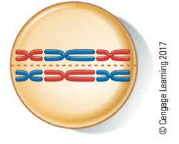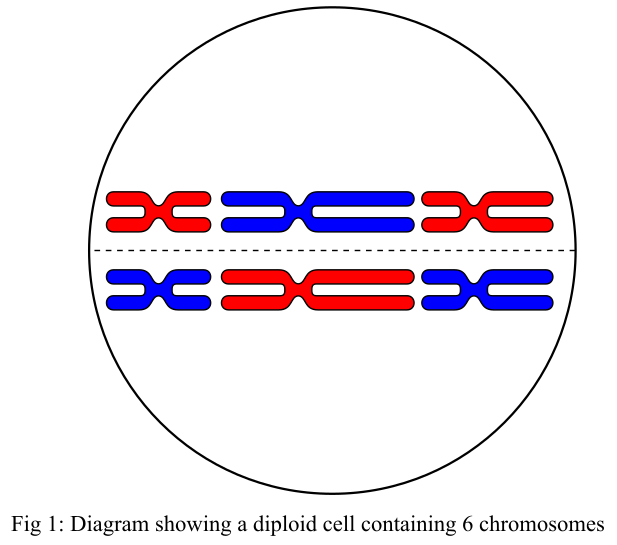
Concept explainers
The chromosome constitution number of this individual is

This drawing represents:
a. mitotic metaphase.
b. meiotic metaphase I.
c. meiotic metaphase II.
d. a gamete.
e. sixnonhomologous chromosomes.
Introduction:
The cell cycle consists of two main divisions known as mitosis and meiosis. Mitosis is the first division during the cell cycle in which the number of chromosomes remains same as the number of chromosomes in the parent cell; on the contrary, in meiosis, the number of chromosomes gets reduced to half.
Answer to Problem 1TYK
Correct answer:
Metaphase 1 of meiosis.
Explanation of Solution
Justification for the correct answer:

Option (b) is meiotic metaphase 1. There are two meiotic divisions after mitosis, namely, meiosis 1 and meiosis 2. During the meiosis 1, the paired chromosomes, also known as bivalent, arrange themselves on the metaphase plate. These paired chromosomes align at the middle of the plate and get attached to the meiotic spindle. The spindle is formed from the structure of the protein, which is responsible for dividing the genetic material in the cell. Hence, option (b) is correct.
Explanation for the incorrect answer:
Option (a) is metaphase in mitosis. Mitosis is the first part of the cell cycle that takes place before the meiosis. Metaphase stage in mitosis involves the arrangement of most condensed chromosomes and these chromosomes then get coiled at this stage. During the metaphase stage of meiosis, the chromosomes are not paired. So, it is an incorrect option.
Option (c) is metaphase 2 phase of meiosis 2. The chromosomes in the meiosis 2 are similar to the chromosomes found in the metaphase stage of mitosis. During the meiosis 2, the chromosomes get condensed and attach themselves to the spindles arising from the centromere present at the opposite poles. These condensed chromosomes are aligned on a metaphase plate but they are in a condensed form. So, it is an incorrect option.
Option (d) is a gamete. During fertilization fusion of one haploid gamete with another haploid gamete results in the formation of a diploid zygote. Number of chromosomes in a haploid cell is 23, two haploid cells fuse together to form a diploid cell. During meiosis number of chromosomes are reduced to 23 from 46 chromosomes. So, it is an incorrect option.
Option (e) states that number of non-homologous chromosomes is 6. Paired chromosomes are the one in which one chromosome is a homolog to another chromosome. These paired chromosomes have the same gene content and possess the same morphology as well. Non-homologous chromosomes are paired chromosomes in which both the chromosomes possess a different gene content. So, it is an incorrect option.
Hence, options (a), (c), (d), and (e) are incorrect.
Therefore, it may be concluded that in the metaphase division of meiosis 1 alignment of paired chromosomes on the metaphase plate takes place. These paired chromosomes get attached to the spindle fibers during this (metaphase 1) stage.
Want to see more full solutions like this?
Chapter 11 Solutions
Biology: The Dynamic Science
- Using information from the primary literature (several references have been provided as a starting point below) please answer the following question: Based on your review of the literature on rewilding, what are the major scientific pros and cons for rewilding? Please note that the focus of this assignment are the (biological) scientific issues associated with rewilding. As will be discussed in class, there are a number of non-scientific issues involved or implicated in rewilding, all ultimately affecting the public acceptability of rewilding. Although these issues are important – indeed, critical – in this assignment you should focus on the biological science issues and questions. Details: You must enumerate at least two pros and at least two cons. Your answer should be no more than 500 well-chosen words, excluding references. Think carefully about how best to organize and structure your answer. Aim for high information density: say a lot, but say it succinctly. Recall Nietzche’s…arrow_forwardNow draw a rough sketch of what the control data might look like if in addition to the specific binding, there was also a considerable amount of nonspecific binding (again using a normal dose/response curve) (do % total bound ligand vs concentration)arrow_forwardWhat are functions of cuboidal cells in the kidney? Select all that apply. Concentration of gases Dilution of chemicals Secretion of molecules Nutrition to tissues Support of tissues Absorption of moleculesarrow_forward
- question1 In plants, epithelial tissue is only found as the outermost cell layer and acts as a barrier. In humans, epithelial tissue is found inside the body as well as on the surface. What function(s) does/do epithelial tissue carry out in humans? Select all that apply. Waste storage Filtration Oxygen transport Protection Diffusion Osmosis Absorptionarrow_forwardWhat words best describes this organism? a. Unicellular/nonmotile Ob. unicellular/motile c. colonial/nonmotile d. colonial/motile e. multicelluar O f. siphonous g. none of thesearrow_forwardIdentify the phylum or class. a. Euglenophyta b. Dinoflagellata c. Bacillariophyceae d. Oomycetes e. Phaeophyceae O f. Myxomycota g. Xanthophyceae ○ h. Chrysophyceae i. Dictyosteliomycota O j. Rhodophyta Ok. Chlorophyceaens I. Charophyceaensarrow_forward
- What is produced inside the indicated structure (Fucus). a. eggs O b. antheridia ○ c. sperm d. zygotes e. none of thesearrow_forwardGreen Algae, as a group, is actually paraphyletic with one subgroup more closely related to higher plants than the other. Which of the following green algae groups is more closely related to higher plants: a. Charophyceans b. Chlorophyceans c. Rhodophyta d. Xanthophyceansarrow_forwardA single-celled green algal genus that is motile with 2 flagella, has a cup shaped chloroplast, and an eyespot: a. Volvox b. Chlamydomonas c. Euglena d. Codiumarrow_forward
- A[n] ___ is produced by members of the Myxomycota when there is a lack of moisture. a. plasmodiocarp b. aethalium c. sclerotium d. plasmodiumarrow_forwardWhich of the following is not true about the life-cycle of Fucus. a. 8 eggs per oogonium b. 64 sperm per antheridium c. eggs are flagellated d. sperm are flagellatedarrow_forwardGreen Algae, as a group, is actually paraphyletic with one subgroup more closely related to higher plants than the other. Which of the following green algae groups is more closely related to higher plants: a. Charophyceans b. Chlorophyceans c. Rhodophyta d. Xanthophyceansarrow_forward
 Biology: The Dynamic Science (MindTap Course List)BiologyISBN:9781305389892Author:Peter J. Russell, Paul E. Hertz, Beverly McMillanPublisher:Cengage Learning
Biology: The Dynamic Science (MindTap Course List)BiologyISBN:9781305389892Author:Peter J. Russell, Paul E. Hertz, Beverly McMillanPublisher:Cengage Learning Biology Today and Tomorrow without Physiology (Mi...BiologyISBN:9781305117396Author:Cecie Starr, Christine Evers, Lisa StarrPublisher:Cengage Learning
Biology Today and Tomorrow without Physiology (Mi...BiologyISBN:9781305117396Author:Cecie Starr, Christine Evers, Lisa StarrPublisher:Cengage Learning Concepts of BiologyBiologyISBN:9781938168116Author:Samantha Fowler, Rebecca Roush, James WisePublisher:OpenStax College
Concepts of BiologyBiologyISBN:9781938168116Author:Samantha Fowler, Rebecca Roush, James WisePublisher:OpenStax College
 Biology 2eBiologyISBN:9781947172517Author:Matthew Douglas, Jung Choi, Mary Ann ClarkPublisher:OpenStax
Biology 2eBiologyISBN:9781947172517Author:Matthew Douglas, Jung Choi, Mary Ann ClarkPublisher:OpenStax Human Heredity: Principles and Issues (MindTap Co...BiologyISBN:9781305251052Author:Michael CummingsPublisher:Cengage Learning
Human Heredity: Principles and Issues (MindTap Co...BiologyISBN:9781305251052Author:Michael CummingsPublisher:Cengage Learning





